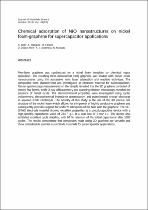 ResearchSpace
ResearchSpace
Chemical adsorption of NiO nanostructures on nickel foam-graphene for supercapacitor applications
JavaScript is disabled for your browser. Some features of this site may not work without it.
- ResearchSpace
- →
- Research Publications/Outputs
- →
- Journal Articles
- →
- View Item
| dc.contributor.author |
Bello, A

|
|
| dc.contributor.author |
Makgopa, K

|
|
| dc.contributor.author |
Fabiane, M

|
|
| dc.contributor.author |
Dodoo-Ahrin, D

|
|
| dc.contributor.author |
Ozoemena, KI

|
|
| dc.contributor.author |
Manyala, N

|
|
| dc.date.accessioned | 2014-05-16T11:34:45Z | |
| dc.date.available | 2014-05-16T11:34:45Z | |
| dc.date.issued | 2013-10 | |
| dc.identifier.citation | Bello, A, Makgopa, K, Fabiane, M, Dodoo-Ahrin, D Ozoemena, KI and Manyala, N. 2013. Chemical adsorption of NiO nanostructures on nickel foam-graphene for supercapacitor applications. Journal of Materials Science, vol. 48(19), pp 6707-6712 | en_US |
| dc.identifier.issn | 0022-2461 | |
| dc.identifier.uri | http://link.springer.com/article/10.1007%2Fs10853-013-7471-x | |
| dc.identifier.uri | http://hdl.handle.net/10204/7411 | |
| dc.description | Copyright: 2013 Springer link. This is an ABSTRACT ONLY. The definitive version is published in Journal of Materials Science, vol. 48(19), pp 6707-6712 | en_US |
| dc.description.abstract | Few-layer graphene was synthesized on a nickel foam template by chemical vapor deposition. The resulting three-dimensional (3D) graphene was loaded with nickel oxide nanostructures using the successive ionic layer adsorption and reaction technique. The composites were characterized and investigated as electrode material for supercapacitors. Raman spectroscopy measurements on the sample revealed that the 3D graphene consisted of mostly few layers, while X-ray diffractometry and scanning electron microscopy revealed the presence of nickel oxide. The electrochemical properties were investigated using cyclic voltammetry, electrochemical impedance spectroscopy, and potentiostatic charge–discharge in aqueous KOH electrolyte. The novelty of this study is the use of the 3D porous cell structure of the nickel foam which allows for the growth of highly conductive graphene and subsequently provides support for uniform adsorption of the NiO onto the graphene. The NF-G/NiO electrode material showed excellent properties as a pseudocapacitive device with a high-specific capacitance value of 783 F g(sup-1) at a scan rate of 2 mV s-(sup1). The device also exhibited excellent cycle stability, with 84 % retention of the initial capacitance after 1000 cycles. The results demonstrate that composites made using 3D graphene are versatile and show considerable promise as electrode materials for supercapacitor applications. | en_US |
| dc.language.iso | en | en_US |
| dc.publisher | Springer link | en_US |
| dc.relation.ispartofseries | Workflow;12590 | |
| dc.subject | NiO nanostructures | en_US |
| dc.subject | Supercapacitors | en_US |
| dc.subject | Electrochemical capacitors | en_US |
| dc.title | Chemical adsorption of NiO nanostructures on nickel foam-graphene for supercapacitor applications | en_US |
| dc.type | Article | en_US |
| dc.identifier.apacitation | Bello, A., Makgopa, K., Fabiane, M., Dodoo-Ahrin, D., Ozoemena, K., & Manyala, N. (2013). Chemical adsorption of NiO nanostructures on nickel foam-graphene for supercapacitor applications. http://hdl.handle.net/10204/7411 | en_ZA |
| dc.identifier.chicagocitation | Bello, A, K Makgopa, M Fabiane, D Dodoo-Ahrin, KI Ozoemena, and N Manyala "Chemical adsorption of NiO nanostructures on nickel foam-graphene for supercapacitor applications." (2013) http://hdl.handle.net/10204/7411 | en_ZA |
| dc.identifier.vancouvercitation | Bello A, Makgopa K, Fabiane M, Dodoo-Ahrin D, Ozoemena K, Manyala N. Chemical adsorption of NiO nanostructures on nickel foam-graphene for supercapacitor applications. 2013; http://hdl.handle.net/10204/7411. | en_ZA |
| dc.identifier.ris | TY - Article AU - Bello, A AU - Makgopa, K AU - Fabiane, M AU - Dodoo-Ahrin, D AU - Ozoemena, KI AU - Manyala, N AB - Few-layer graphene was synthesized on a nickel foam template by chemical vapor deposition. The resulting three-dimensional (3D) graphene was loaded with nickel oxide nanostructures using the successive ionic layer adsorption and reaction technique. The composites were characterized and investigated as electrode material for supercapacitors. Raman spectroscopy measurements on the sample revealed that the 3D graphene consisted of mostly few layers, while X-ray diffractometry and scanning electron microscopy revealed the presence of nickel oxide. The electrochemical properties were investigated using cyclic voltammetry, electrochemical impedance spectroscopy, and potentiostatic charge–discharge in aqueous KOH electrolyte. The novelty of this study is the use of the 3D porous cell structure of the nickel foam which allows for the growth of highly conductive graphene and subsequently provides support for uniform adsorption of the NiO onto the graphene. The NF-G/NiO electrode material showed excellent properties as a pseudocapacitive device with a high-specific capacitance value of 783 F g(sup-1) at a scan rate of 2 mV s-(sup1). The device also exhibited excellent cycle stability, with 84 % retention of the initial capacitance after 1000 cycles. The results demonstrate that composites made using 3D graphene are versatile and show considerable promise as electrode materials for supercapacitor applications. DA - 2013-10 DB - ResearchSpace DP - CSIR KW - NiO nanostructures KW - Supercapacitors KW - Electrochemical capacitors LK - https://researchspace.csir.co.za PY - 2013 SM - 0022-2461 T1 - Chemical adsorption of NiO nanostructures on nickel foam-graphene for supercapacitor applications TI - Chemical adsorption of NiO nanostructures on nickel foam-graphene for supercapacitor applications UR - http://hdl.handle.net/10204/7411 ER - | en_ZA |





